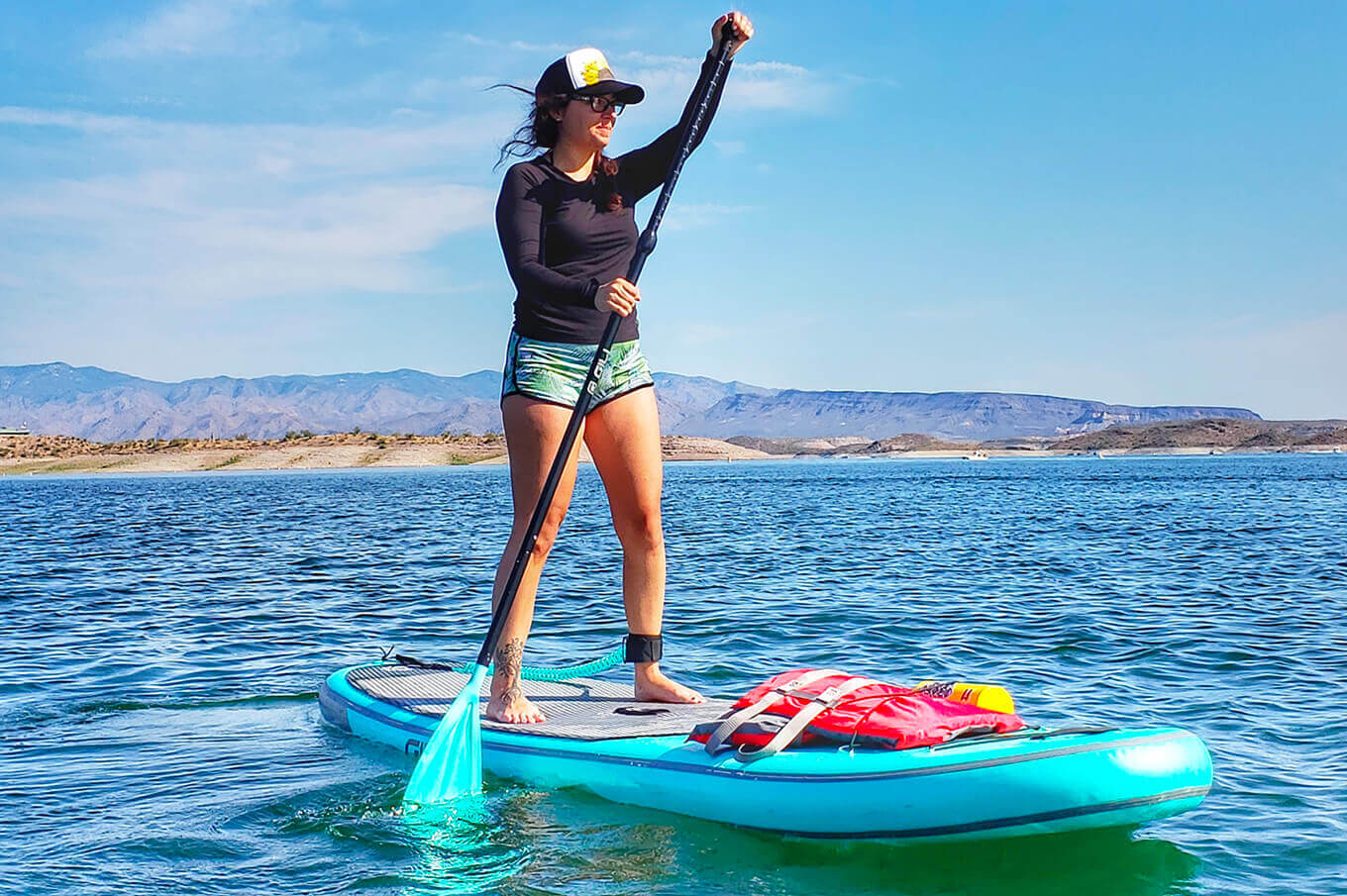Ready to conquer the waves but unsure how to stand up on a paddle board? We’ve got you covered! In this blog, we’re sharing our top tips, techniques, and strategies to help you rise from a beginner to a paddleboard pro. We’ll walk you through the importance of starting in calm waters, the art of balance, and the step-by-step process of standing up on your board. Let’s dive into this exciting journey of paddle boarding together!
How Do You Stand on a Paddle Board for Beginners?
Standing up on a paddle board can appear daunting at first, but with the right guidance and practice, we assure you that it’s an achievable feat. Here, we’ll break down the process into simple, manageable steps that a beginner can easily follow.
Transitioning from kneeling to standing on a paddle board involves these three key steps:
- Plant hands directly under the shoulders for support: This provides a sturdy base to push yourself up from.
- Push up into a high-kneel position: From here, you’re already halfway to standing. It’s crucial to maintain balance during this transition.
- Slowly lift one foot, followed by the other, to stand up: Take your time during this step. It’s better to do it slowly and correctly than rush and risk losing balance.

What is the Technique to Standing on a Paddle Board?
Understanding the technique to standing on a paddle board is crucial if you’re going to enjoy the experience. It’s not just about getting on the board; it’s about maintaining your balance and adjusting your body position safely. Let’s delve deeper into this.
Correct Body Position for Standing on a Paddle Board
- Firstly, the correct body position plays a significant role in maintaining balance and control. Your feet should be parallel and hip-width apart. This stance provides a solid base of support when you’re standing on a paddle board.
- Secondly, keep your knees slightly bent. This not only aids in balancing but also prepares your body for any unexpected shifts in water movement.
- Lastly, ensure your back is straight, and your gaze is forward. This posture helps maintain balance and allows you to paddle effectively.
Tips for Maintaining Balance Once Standing
Once you’re standing, maintaining balance on a paddle board can be a challenge, especially for beginners. Here are some tips we’ve found helpful:
- Shift your weight by moving your hips, not your upper body. This keeps your center of gravity low and helps maintain stability.
- Keep your core engaged. A strong core is crucial for balance as it stabilizes your entire body.
- Use your paddle for additional balance. When used correctly, your paddle can act as a third point of contact with the water, providing extra stability.
Safe Ways to Adjust Body Position While On the Board
Moving around on a paddle board requires careful adjustments to avoid tipping over. Here’s how to do it safely:
- Move one foot at a time. This allows you to maintain three points of contact with the board, increasing your stability.
- Keep your knees bent while adjusting. This lowers your center of gravity, making it easier to balance.
- Hold onto your paddle while moving. Your paddle can provide additional support and balance as you adjust your stance on the board.

Why Can’t I Stand Up on My Paddle Board?
Common Reasons Beginners Struggle to Stand up on Paddle Boards
There are a few common reasons why beginners may struggle to stand on their paddle boards.
- Lack of core strength: Core strength is pivotal in maintaining balance on a paddle board. If your core muscles are weak, you might find it difficult to keep your balance and stand up on the board.
- Incorrect foot positioning: The positioning of your feet on the board can greatly impact your balance. If your feet are placed incorrectly, you may struggle to stand and maintain balance.
- Fear of falling: A common fear among beginners is the fear of falling into the water. This fear can cause tension in the body, making it difficult to stand up on the board.
How to Identify and Correct Mistakes
Identifying and correcting your technique can greatly improve your ability to stand up on a paddle board. Here’s how you can do that:
- Watch instructional videos or take classes
- Practice on land before moving to water
- Request feedback from experienced paddle boarders
Tips for Overcoming Fear and Building Confidence
We understand that standing up on a paddle board can be intimidating at first. However, with practice and the following tips, you can overcome your fear and build confidence:
- Start in shallow waters: Starting in shallow waters where you can easily touch the bottom can reduce the fear of falling.
- Practice falling and getting back up: The best way to overcome the fear of falling is to practice falling! The more you fall and get back up, the more comfortable and confident you’ll become.
- Gradually increase time spent standing on the board: Start by standing for short periods, then gradually increase your standing time as your confidence grows.

Conclusion
Standing up on a paddle board sure sounds tricky, right? But don’t worry, we’ve got your back! Picking a calm spot and feeling your balance on the knees comes first. Then, step by step, you’ll get the hang of standing up.
Keeping your core strong and your feet right helps a ton. And it’s okay to be scared of falling. We all were at first! But with time, you’ll get braver and stronger.



